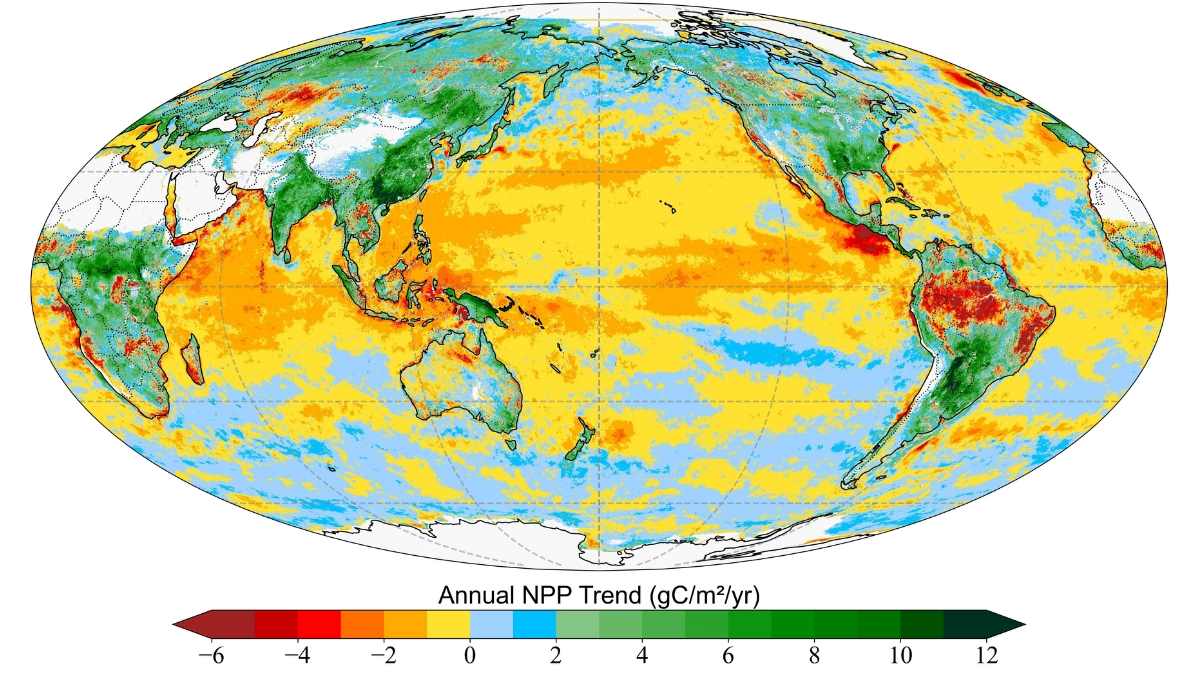The annual trend in global net primary production (NPP), or net carbon gain by photosynthetic organisms on Earth, from 2003 to 2021. Credit: Yulong Zhang, et al, 2025
A new study has found that while plants on land have driven an overall increase in global photosynthesis production, marine plant photosynthesis is on the decline.
The study highlights the ocean’s greater sensitivity to future climate variability, and the important role terrestrial plants play in offsetting the declining production of energy among marine phytoplankton.
The authors warn that if declines continue, it could have devastating consequences across the entire food chain network, impacting local economies, biodiversity and fisheries and intensifying climate change.
“As the foundation of food webs, net primary production determines ecosystem health, provides food and fibres for humans, mitigates anthropogenic carbon emissions and helps to stabilise Earth’s climate,” says first author Dr Yulong Zhang from Duke University’s Nicholas School of the Environment in the US.
Net primary production (NPP) refers to the rate energy is produced by plants and photosynthetic materials after accounting for respiration. This is essentially all the energy that is then available for animals to eat, which is transported through the food chain.
Most past studies on NPP have focused on ocean environments or land ecosystems, but not both. The Duke team incorporated both biospheres in their study to provide a fuller picture of global NPP.
“If you’re looking at planetary health, you want to look at both terrestrial and marine domains for an integrated view of net primary production,” says co-author Nicolas Cassar, a professor of biogeochemistry at Duke.
The team estimated the annual trends and variability in global NPP using computer models which combined satellite data with variables such as light availability, precipitation and air and sea-surface temperature.
Satellite instruments can measure how green the Earth’s surface is, which represents the abundance of a green pigment called chlorophyll produced by photosynthetic life.
Using specialised satellite datasets from 2003 to 2021, the authors estimated the annual changes in net primary production for 3 land datasets and 3 ocean datasets.
The results, published in a paper in Nature Climate Change, show that overall global NPP increased at a rate of 0.1 billion metric tons of carbon per year within the research period.
This was mainly driven by a significant increase in terrestrial NNP, at a rate of 0.2 billion tonnes of carbon per year.
“The shift toward greater primary production on land mainly stemmed from plants in higher latitudes, where warming has extended growing seasons and created more favourable temperatures, and in temperate regions that experienced local wetting in some areas, forest expansion and cropland intensification,” says co-author Wenhong Li, a professor of earth and climate sciences at Duke.
However, there was a decline in marine NPP of about 0.1 billion metric tons of carbon per year. These strong declines were mainly observed in tropical and subtropical oceans and the Pacific Ocean.
“Rising sea surface temperatures likely reduced primary production by phytoplankton in tropical and subtropical regions,” says Cassar.
“Warmer waters can layer atop cooler waters and interfere with the mixing of nutrients essential to algal survival.”
Marine NPP varied each year, depending on the presence of climate events like La Niña.
“We observed that ocean primary production responds much more strongly to El Niño and La Niña than land primary production,” says co-author Shineng Hu, an assistant professor of climate dynamics at Duke.
“This finding highlights the ocean’s greater sensitivity to future climate variability.”
Algae, plants and trees can all act as carbon sinks, absorbing CO2 and removing the greenhouse gas from the atmosphere. The declines in marine NPP could interfere with the ability of these photosynthetic organisms to act as sinks which could potentially intensify the impacts of global warming.
“Long-term, coordinated monitoring of both land and ocean ecosystems as integrated components of Earth is essential,” says Zhang.
“Whether the decline in ocean primary production will continue — and how long and to what extent increases on land can make up for those losses — remains a key unanswered question.”
